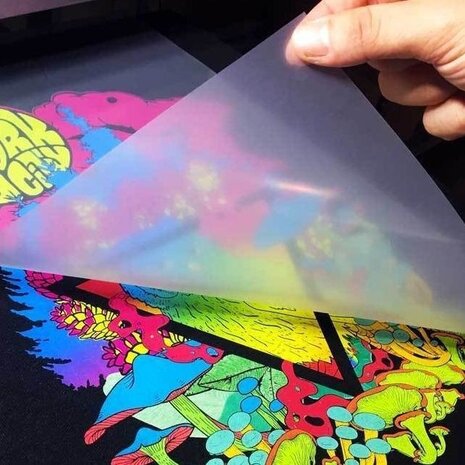WHAT IS DTF?
Introduction
In the dynamic realm of custom apparel, one term that resonates frequently is "DTF." It's not just an acronym; it's a game-changer. Imagine a world where customization meets efficiency — that's the essence of DTF transfers. Today, we embark on a journey to unbox this term, exploring its applications, creation process, and why it has become a go-to in the custom apparel industry.

Defining DTF
DTF stands for Direct to Film, a term buzzing in the custom apparel industry. But what sets it apart? In simpler terms, DTF is a full-color heat press transfer similar to its screen-printed counterpart. Let's dive into the intricacies of what makes DTF transfers unique. A DTF is a fantastic option for a full-color graphic with no minimum. DTF transfers can be applied to apparel with no requirements or pretreatment.
Applications of DTF

Beyond the buzzword, DTF transfers are the artisans' tool for customizing apparel. Picture not just decorated T-shirts but bags, jeans, and even shoes transformed into personalized masterpieces. They are so easy to apply to items. All you need is a heat press. You can even purchase them from our website; we will ship them to you. So you can apply them to your garments. Or we offer a house option, so you do not need to do any extra work but re-sale or wear the item.
Comparing Methods
How does DTF stack up against other printing methods? From screen printing to direct-to-garment, we'll unravel the advantages and disadvantages, showcasing why DTF shines in specific scenarios. DTF is easy. Anyone can do it where screen printing and direct-to-garment require very pricey equipment. DTF, all you need is a heat press to apply your print. The feel is very similar and lasts up to 50-100 washes.
The Process Unveiled
Now, let's step into the workshop and understand the meticulous process of applying DTF transfers. It involves a dance with a heat press, where the transfer meets fabric. Learn the nuances of temperature, pressure, and duration, deciphering the magic behind hot and cold peel transfers. The process of a DTF transfer starts with the artwork. We can create custom artwork or use pre-made work. All we need is a PNG with a transparent background. Once we have the artwork, the next step is to print the transfers using a direct-to-film printer. These printers are a special mix of a CMYK printer with some white ink added, so it is a 7-color printer. That prints directly on a film, and then glue is added to make it able to be heat applied. Once you have a print, you can use your heat press. All transfers differ depending on the company you purchase from because of the type of paper and ink it is printed on. Our transfers are applied at 320 degrees for 20 seconds at a medium pressure. Then, please wait 30 seconds and peel it to a warm temperature. You then press it one more time to give it a matt finish.
Benefits Beyond the Press
What makes DTF a favorite in the industry? They are so easy to use that they can start their own t-shirt business, which is the newest trend! Everyone sells T-shirts now, why can't you? Explore the economic advantages, especially for short runs, and the option of ordering gang sheets — a sheet housing multiple transfers at a discounted price. The price point of DTF transfer is great. You bought just one or 100s and got a fraction of what a DTG print would cost. But screenprinting is always cheaper if you have a bulk order.
Conclusion

DTF transfers are the artisans' choice in a world where customization meets technology. From its definition to applications, the meticulous process, and the technological wizardry, we've peeled back the layers of DTF. Now, armed with knowledge, explore the realm of custom apparel confidently, knowing that DTF is not just a term but a transformative tool.
SP101 offers high-quality DTF transfers at great rates and includes contract rates.


